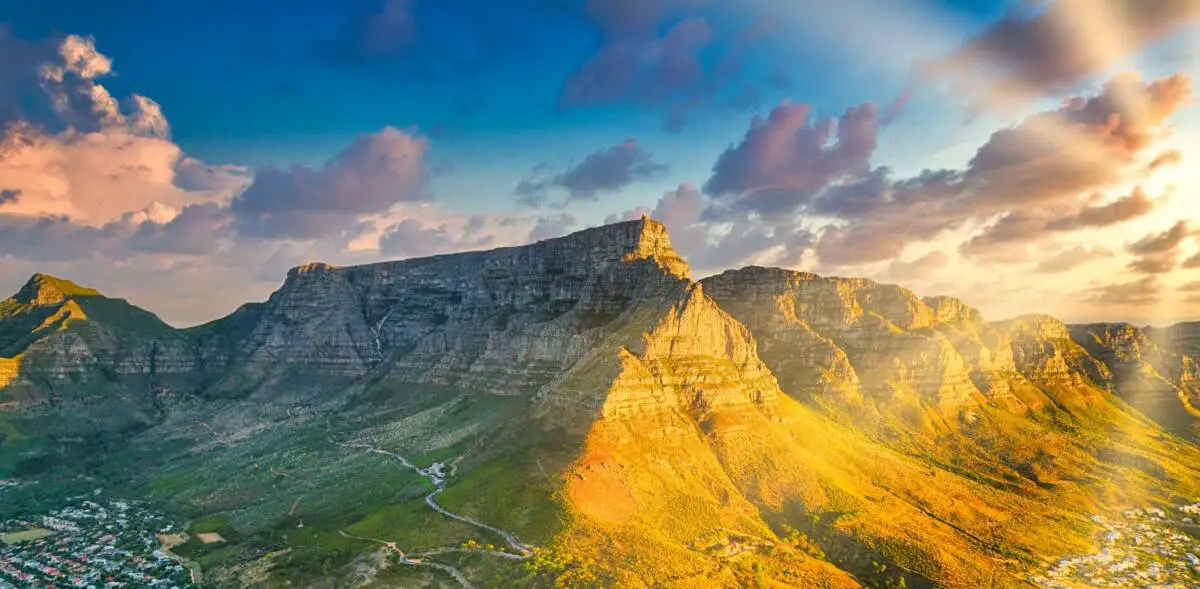Table Mountain was recently voted one of the New Seven Wonders of Nature. We took the cable car to the top to find out why. Join us as we discover 12 reasons to visit this iconic place of natural beauty with spectacular views of Cape Town.
The view from the top of Table Mountain alone makes it worth the visit – especially on a clear day. In addition to the views, there are interesting plants and animals to see, easy paths to explore, and wonderful photo opportunities abound.
12 Reasons to Visit Table Mountain, Cape Town, South Africa
- Views from the cable car are amazing
- Trails suitable for all ages
- You can join a guided walk for free
- Richest floristic region in the world
- Watch hyrax, closely related to elephants
- Venomous snakes are hard to find
- No mischievous baboons at the top
- One of the oldest mountains on earth
- Table Mountain gives Cape Town its sunny climate
- Recognized as a World Heritage Site
- Famous site for scientific research
- Learn about the famous legend of the tablecloth
Take a look at the amazing views via my 360 video.
Check out my 360 video — don’t forget you can spin the view as the video plays!

1. Views from the cable car are amazing
Wonder if it is worth paying the price for the cableway? Yes! It is definitely worth the price in our experience. Taking the cable car gives you a real sense of how high you are ascending as you watch the city grow smaller and smaller and the rugged cliffs whizz by below.
In 1997, an advanced cable car system was installed. The cable cars slowly rotate as they ascend and descend, giving each of the 65 passengers a dynamic 360° view of the scenery. Our trip down was enchanting as we watched the glittering lights below and the dramatic skies after sunset.
2. You can find hiking trails suitable for people of all ages and abilities
There are dozens of relatively steep trails that will take you to the top of Table Mountain. Or you can take the cable car to the top, where you’ll find three easy hiking trails to explore the top of the mountain.
The Dassie Walk offers spectacular views to the north, south and west. The Agama Walk will provide you with 360° aerial views of Cape Town and the Cape Peninsula. The Klipspringer Walk will take you along the edge of the plateau to the top of Platteklip Gorge.
3. You can join a guided walk for free
Short guided walks that are free of charge depart daily from the Twelve Apostles Terrace (below the Shop at the Top and the Table Mountain Café) on the hour from 9am to 3pm.
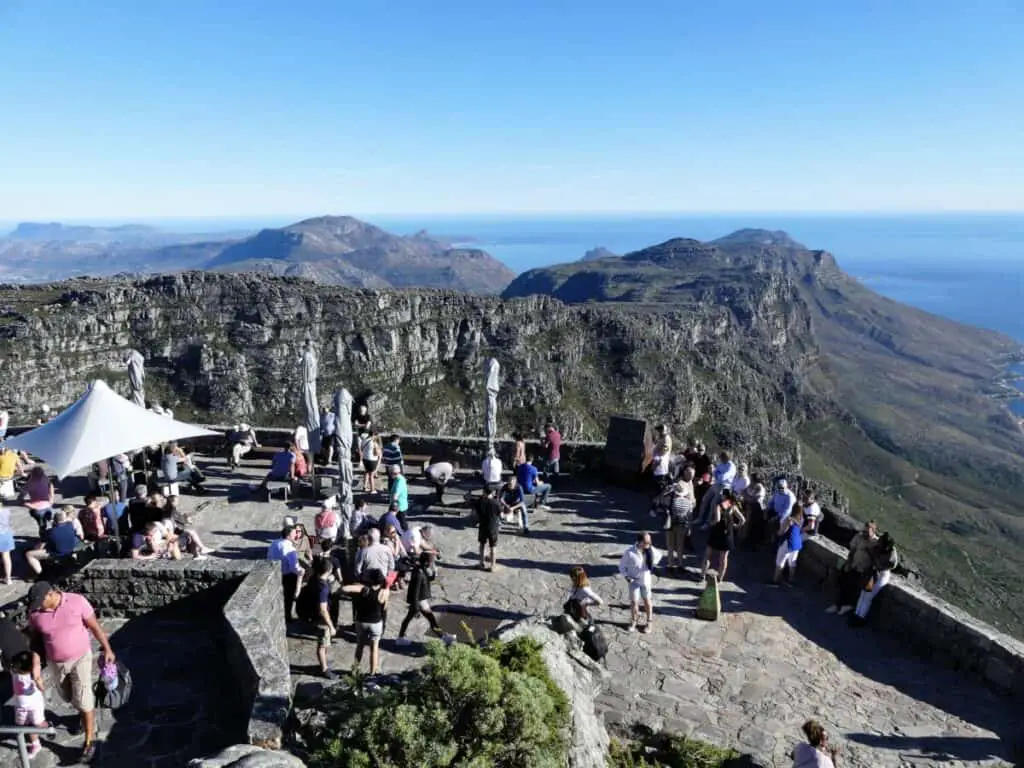
4. Visit the richest floristic region in the world
Table Mountain is an important part of the Cape Floristic Region the smallest and richest of the six floral kingdoms. It is also the only kingdom confined to one continent and is home to an amazing 8,200 species of plants. The entire UK has about 1,500 species by comparison.
This is a good place to see fynbos vegetation, with over 1,460 different species of plants, 300 of which are endangered, with 29 already extinct. Fynbos is fire adapted vegetation, and the plants that make up fynbos today have been subjected to burning over thousands of years. Healthy fynbos requires regular burning every 10–15 years to maintain populations of the larger Protea species.
Fynbos probably helped save humanity over 100,000 years ago in coastal parts of Africa, according to research by Curtis Marean (“When the Sea Saved Humanity,” Scientific American, 1 Nov. 2012). These plants have the greatest diversity of geophytes in the world—underground energy-rich tubers and bulbs.
5. You can watch animals closely related to elephants
There’s one animal that you have a good chance of seeing at the top of the cliffs, the rock hyrax (Procavia capensis). If you ask a local, they will likely call this animal a dassie or, in Afrikaans, the klipdassie. They look a bit like a giant guinea pig that weighs about 10 lbs (4 – 5 kg) and has short ears and a short tail.
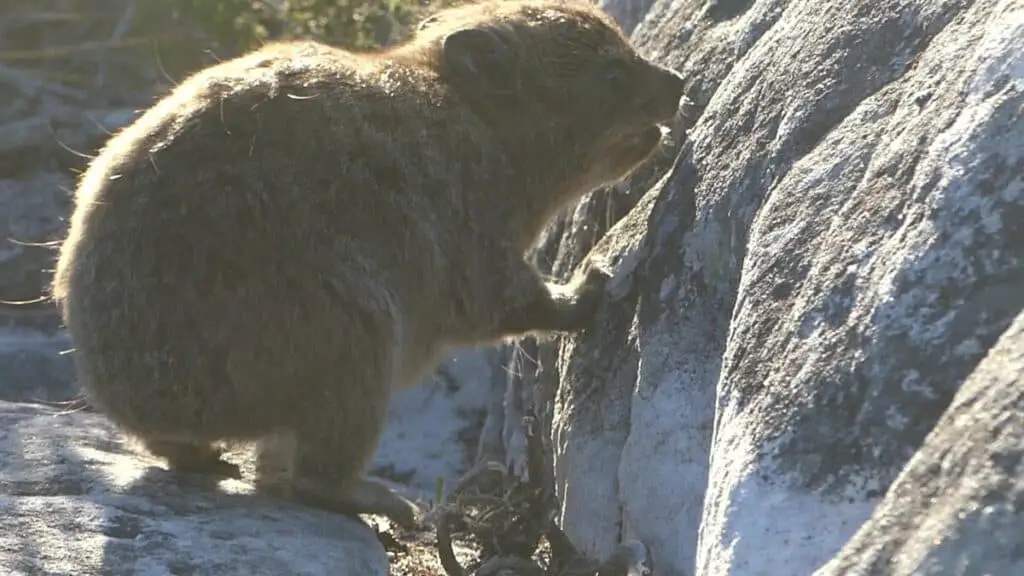
But these are no guinea pigs, in fact their closest relative is the elephant. They even have tusks – long, pointed tusk-like incisors. And, like elephants, hyraxes have flattened, hoof-like nails on their toes, rather than claws. As a young naturalist I was keen to see a rock hyrax, being intrigued about the connection between this small rodent-like creature and the largest land mammal on the planet.
Life as a rock hyrax must be pretty good since they spend about 95% of their time resting and basking in the sun. On Table Mountain they probably kick back and enjoy the view!!
Too much information!
Rock hyraxes produce large quantities of hyraceum—a sticky mass of dung and urine. Apparently, it is used as a folk remedy for treating epilepsy and convulsions. It is also used to make perfume. Don’t know if it attracts women, men… or rock hyraxes!! You might want to avoid wearing this one… at least on Table Mountain.
6. Venomous snakes are hard to find
Yes, Table Mountain is home to 22 species of snake, and more than half of them are venomous. However, your chances of meeting a snake are very very slim. Sorry, hard core snake enthusiasts, I hate to disappoint.
The five most dangerous species on Table Mountain are the puff adder (Bitis arietans), Cape cobra (Naja nivea), boomslang (Dispholidus typus), rinkhals (Hemachatus haemachatus) and berg adder (Bitis atropos).
Probably the most dangerous snake is the puff adder. The thing you need to know about puff adders is that they rely on their camouflage and are reluctant to move out of your way. They have a potent venom, they will bite if stepped upon, and they have long fangs. They are usually about 3 feet or one meter in length. The berg adder looks similar but is not deadly to humans. My advice?? Watch where you tread. Oh, yeah… don’t poke at any snake with a stick! That’s how people die and simultaneously prove Darwin correct.
The other snakes tend to be shy and present less of a problem. The Cape cobra will strike but is usually found in trees. The highly venomous boomslang is small, frequents the trees, and will avoid people whenever it can. The rinkhals is a type of spitting cobra that will spread its hood as a warning when threatened. Which is good to know, considering it will try to spit venom into your eyes!
7. You won’t see baboons at the top!
Table Mountain National Park covers a big area that includes much of the Cape of Good Hope. You may have read warnings about baboons in Table Mountain NP grabbing food and acting aggressively. Turns out that the warnings do not refer to the top of the mountain – but rather to the lowland stretches of the National Park and some surrounding urban areas. Chacma baboons did at one time live in the pine plantations on the slopes of Table Mountain. However, as the pines were cut down in the 1960s, the baboons left the mountain and started to move into urban areas in search of food.
The city of Cape Town has about 60 field rangers to keep baboon troops in check, and they are armed with paintball guns and bear bangers.
If you go to Cape Point, keep an eye out for the chacma baboons. They regularly attack tourists. They won’t hurt you much, but steal food and other things from you. If one approaches you, walk backwards slowly, facing the baboon. When driving near baboons be sure to keep all the windows closed!
8. Table Mountain is one of the oldest mountains on earth
Table Mountain is six times older than the Himalayas and five times older than the Rocky Mountains. Around 800 million years ago sandstone was being deposited underwater. Around 300 million years ago, during an ice age, the top of the mountain was at sea level and ice sheets ground away layers of sandstone to create the flat surface of the ‘Table Top’.
The reason Table Mountain stands so tall above the surrounding area is that the sandstone contains quartzite and is very resistant to weathering.
9. Table Mountain made Cape Town what it is today
The mountain traps moisture in the form of clouds, providing rain and feeding the streams that flow through the valleys. Over millennia, forests have grown in the ravines and soil has developed on the mountain slopes, in contrast to the sandy plains beyond. Trapping the moisture as it does, the mountain creates a rain shadow with plentiful sunshine.
These features have attracted human settlement and without the mountain Cape Town would not exist as we know it today.


10. Recognized as a World Heritage Site
In 1998, President Nelson Mandela proclaimed a large part of the Cape Peninsula as a National Park, now called Table Mountain National Park. In 2004 the Cape Floristic Region was declared a Natural World Heritage Site, including Table Mountain National Park.
The Cape Floristic Region “…is one of the world’s great centres of terrestrial biodiversity,” according to UNESCO. “The extended property includes national parks, nature reserves, wilderness areas, state forests and mountain catchment areas.”
The Table Mountain range has the highest concentration of threatened species of any continental area of equivalent size in the world.
11. The mountain is famous for science
The highest point of Table Mountain is Maclear’s Beacon, a stone cairn built in 1844 by Sir Thomas Maclear for trigonometrical survey. It is 1,086 metres (3,563 ft) above sea level, about 19 metres (62 ft) higher than the cable station.
The beacon was used as triangulation station to assist in measuring the curvature of the Earth and is still used by cartographers. Maclear’s re-calculation proved the shape of the earth as we know today.
12. Fun Fact: the tablecloth is the stuff of legend
When you view Table Mountain from below, you will often see the flat top covered in a distinctively shaped flattish cloud – the tablecloth. This is an orographic cloud formation, formed as south-easterly winds push moisture up the steep slopes to the top. The colder air at the top causes the moisture to condense and form clouds. Locals refer to the refreshing south-easterly winds as the Cape Doctor.
Taxi drivers love to retell a far-fetched local legend that explains the presence of the cloud: a smoking contest between the Devil and a local pirate called Van Hunks. When Van Hunks won the contest, the Devil being a poor loser made them both vanish in a puff of smoke. To this very day, the Devil of Devil’s Peak and Van Hunks continue their challenge, covering the top of Table Mountain with their pipe smoke.
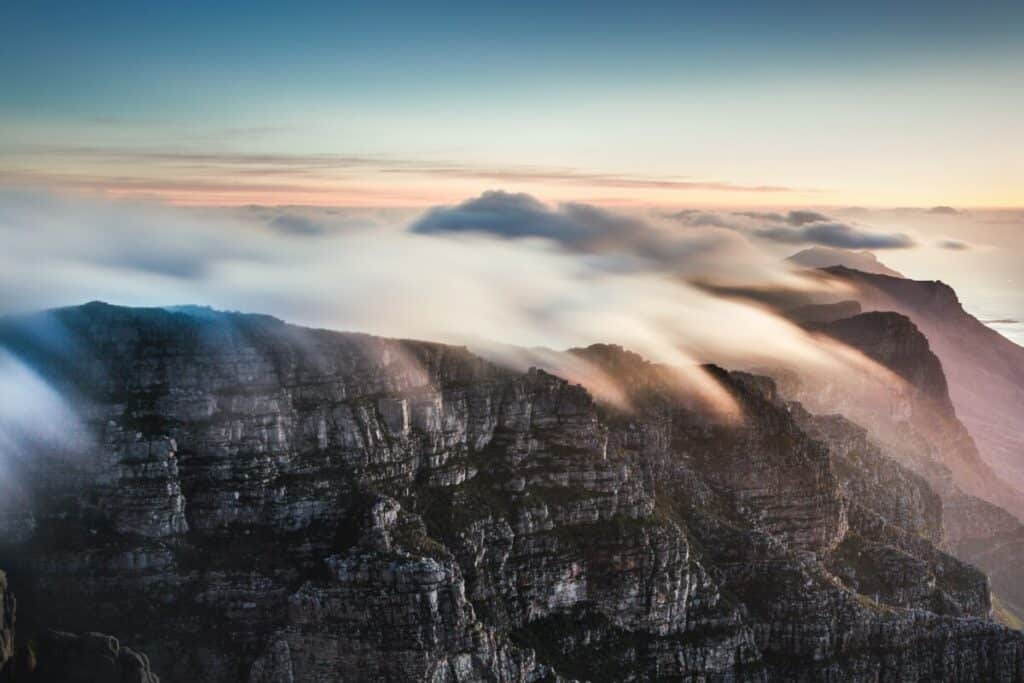
Bonus Not So Fun Fact: the cable car can stop running any time
The cableway company posts this reminder on its website: Remember that the Cableway can close at any time due to unpredictable weather conditions. Don’t rely on being able to ride it up or down, even if you’ve already checked whether it’s open. If you intend taking the Cableway down, make sure that it is operating on the day but leave yourself enough time to hike down before sunset if needs be.
This is a sobering thought! On the day we were there, hundreds of us sat enjoying the view at sunset with a drink in hand. The crowd included many families with small children. I couldn’t imagine those people making it to the bottom in one piece!
The wind in Cape Town can be very fickle, and it can blow much stronger on top of the mountain than in the city. If the wind picks up too much, the Cableway has to close. I began to wonder how often this happened?? The answer is between 60 and 90 days each year.
Thankfully, I came across the following clarification elsewhere on the website:
“While the cable cars can withstand the wind, best practice dictates that we cease operating. Once all our visitors have been safely brought down from the summit, our staff members continue with their day.”
Whew! That’s a relief!
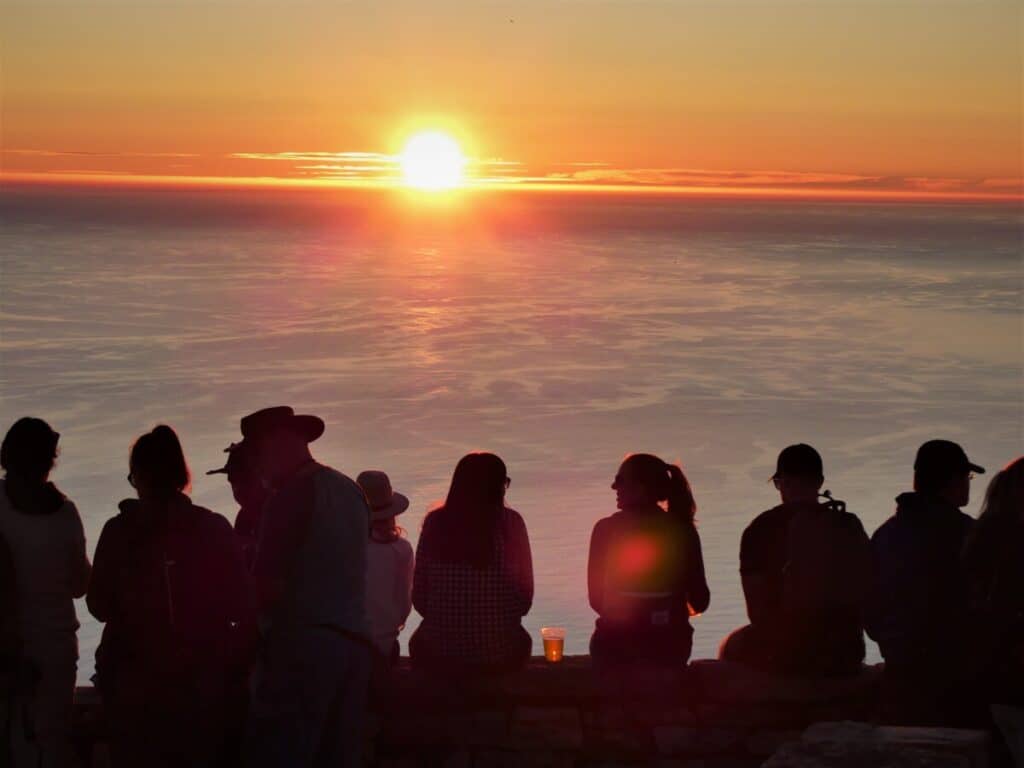
Banner photo: Table Mountain by Thomas Bennie on Unsplash. Thank you for a great shot!

